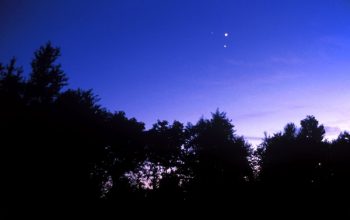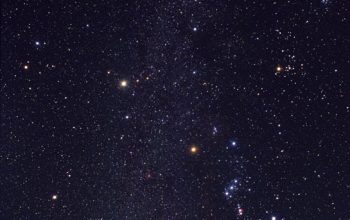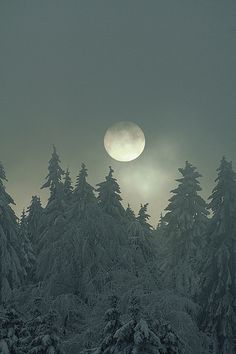Sunday, October 9th:
Mercury emerges close to the horizon during twilight hours. Look below the constellation Leo to spot the faint and fast moving world. Although tricky to spot even with a clear eastern horizon, it’s a wonderful opportunity to try. By next week, Mercury will be even lower to the horizon. The planet never strays far from the Sun, and now is the best time to observe it before it becomes nearly impossible. The Moon is 53% illuminated at First Quarter, with moonrise at 2:26pm and moonset at 12:28am.
Monday, October 10th:
Before sunrise on Tuesday morning (10/11), Mercury and Jupiter will have a close conjunction. About 45 minutes before your local sunrise, they’ll be 0.8 degrees apart above the low eastern horizon. Jupiter will shine to the right of the fainter Mercury.
The Moon is 63% illuminated as a Waxing Gibbous, with moonrise at 3:09pm and moonset at 1:29am on 10/11.
Tuesday, October 11th:
The stars of the Big Dipper represent five members of the Ursa Major constellation. The Big Dipper hovers just above the northwest horizon during the fall. To predict where the Big Dipper will be in the sky depends on the season. It revolves counterclockwise around Polaris, commonly known as the North Star. The Big Dipper is directly below Polaris in autumn and directly above in the spring. To help remember, think of the phrase, spring up and fall down.
The Moon is 73% illuminated as a Waxing Gibbous, with moonrise at 3:48pm and moonset at 2:35am on 10/12.
Wednesday, October 12th:
Spot Formalhaut, or the “Autumn Star”, about 20 degrees below the Moon late in the evening. The Moon is 82% illuminated as a Waxing Gibbous, with moonrise at 4:25pm and moonset at 3:44am on 10/13.
Thursday, October 13th:
Uranus reaches opposition-when it lines up opposite to the Sun relative from Earth. It rises at Sunset and is viewable all night. Regardless, it will still be faint and you’ll need a pair of binoculars to properly observe it in the constellation Pisces.
The Moon is 90% illuminated, with moonrise at 5:01pm and moonset at 4:56am on 10/14.
Friday, October 14th:
Uranus continues opposition, viewable with binoculars to the lower left of the Moon.
The Moon is 96% illuminated, with moonrise at 5:36pm and moonset at 6:10am on 10/15.
Saturday, October 15th:
The Full Moon consumes the sky with light tonight. Being the first full Moon after the Harvest Moon, we refer to it as the Hunter’s Moon. The Moon is 99% illuminated, with moonrise at 6:50pm and moonset at 7:25am on 10/16.
Happy stargazing!
-Julia
NOTE: Times for moonrise and moonset are calculated from our base in New York. Click here to get your local times.
Sources: Earth and Sky, Sky and Telescope, Timeanddate.com, moongiant.com, StarDate.org, SkyNews.


